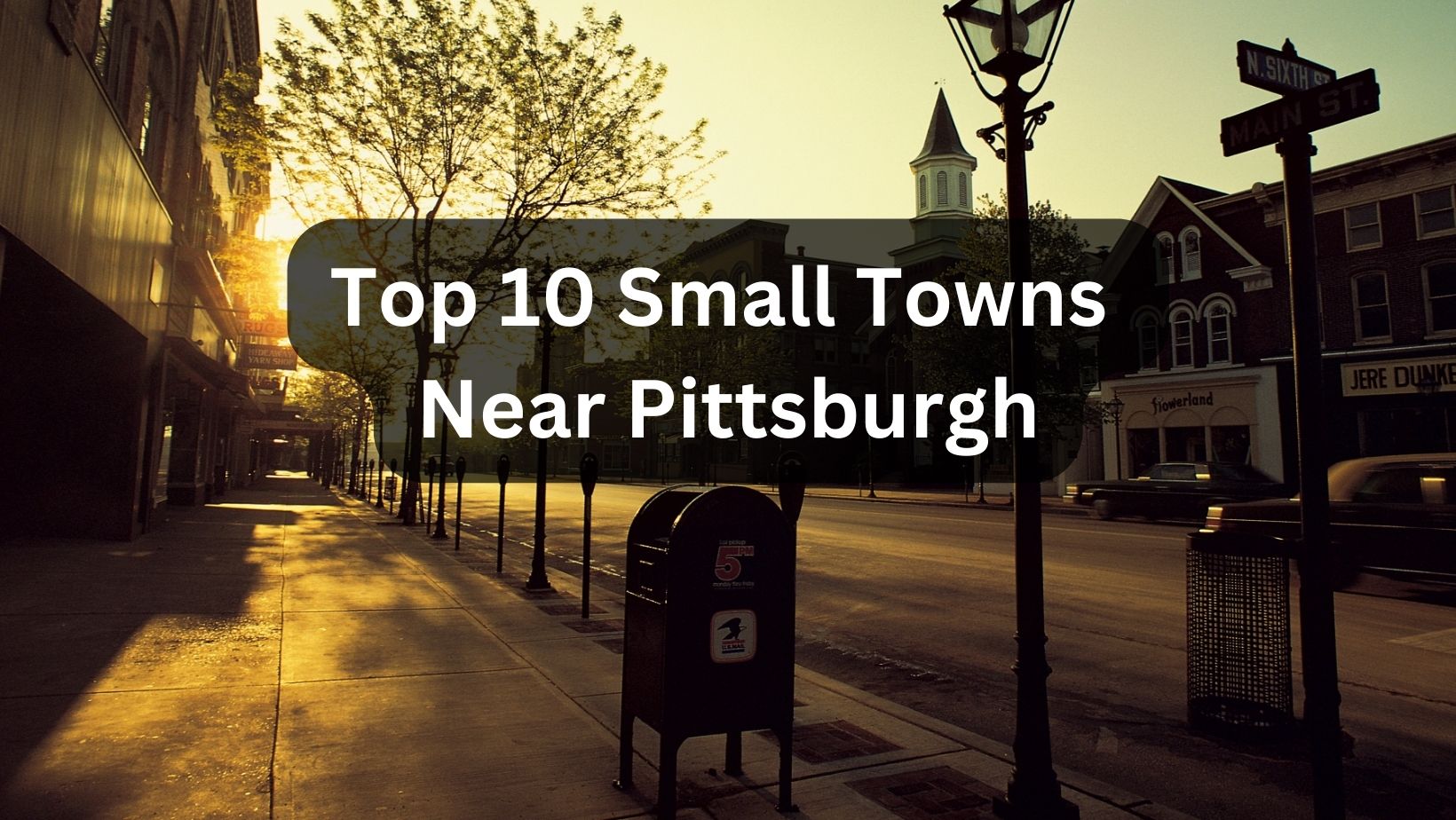Nestled in the picturesque landscapes of Western Pennsylvania, just a short drive from the vibrant city of Pittsburgh, you’ll discover a collection of charming small towns. These top ten towns near Pittsburgh entice with a delightful mix of history, community camaraderie, and scenic beauty. Join us on this journey as we explore the outskirts of Pittsburgh, unveiling the distinctive charm and individual character that each of these small towns has to offer. While we are certainly partial to Smicksburg, we hope you’ll explore many of these towns, including our own!
- Smicksburg: Located about 60 miles northeast of Pittsburgh, Smicksburg is a charming Amish community known for its picturesque countryside, historic buildings, and local artisans. Visitors can explore quaint shops, visit their historical park, and enjoy homemade goods such as furniture, cheese, wine and decor.
- Ligonier: Nestled in the Laurel Highlands, Ligonier is a historic town with a vibrant downtown area. It offers a blend of history, natural beauty, and outdoor activities. Explore the Fort Ligonier Museum, stroll along the picturesque Diamond Park, or hike the nearby trails in Linn Run State Park.
- Harmony: Situated along the Connoquenessing Creek, Harmony is a National Historic Landmark District. It features beautifully preserved 19th-century buildings and charming shops. Visit the Harmony Museum to learn about the town’s history, explore the picturesque streets, and enjoy the serene ambiance.
- Saxonburg: Founded by German immigrant John Roebling, Saxonburg is a small town with a rich history. It is known for its Victorian-era architecture, Roebling Park, and the Roebling Bridge, which was a precursor to the Brooklyn Bridge. Explore the town’s heritage at the Roebling Museum and stroll along Main Street to admire the quaint buildings.
- Zelienople: Located in southern Butler County, Zelienople is a small town with a thriving arts community. Its downtown area is lined with unique shops, art galleries, and antique stores. Visit the Strand Theater, which hosts various cultural events, and enjoy outdoor activities at the nearby Glade Run Lake.
- Oakmont: Situated along the Allegheny River, Oakmont is a picturesque town known for its beautiful architecture and the prestigious Oakmont Country Club, which has hosted numerous major golf championships. Take a walk along the quaint streets, visit the local boutiques and eateries, and enjoy the scenic riverfront views.
- Sewickley: Just 12 miles northwest of Pittsburgh, Sewickley is a charming town with a rich history and elegant residential areas. Its vibrant downtown area features boutique shops, art galleries, and restaurants. Explore the Sewickley Heights History Center, stroll along the Sewickley Bridge, and visit the picturesque Sewickley Heights Borough Park.
- Mars: Situated in Butler County, Mars is a small town with a unique name and a rich history. It offers a blend of small-town charm and modern amenities. Stroll along the Main Street, visit the Mars History & Landmarks Society, and enjoy the outdoor spaces like Mars Community Park and Adams Township Community Park.
- Ohiopyle: Located about 60 miles southeast of Pittsburgh, Ohiopyle is a small town known for its natural beauty and outdoor activities. It is home to Ohiopyle State Park, where visitors can enjoy hiking, biking, whitewater rafting, and camping. Explore the iconic Ohiopyle Falls, go for a swim in the Youghiogheny River, or hike the Ferncliff Peninsula Nature Reserve.
- Volant: Situated in Lawrence County, Volant is a small village known for its quaint shops and Amish influence. Stroll along Main Street, browse through the unique stores offering handmade crafts, furniture, and locally produced foods. Don’t miss the annual Volant Mills Antique and Crafts Show, which attracts visitors from across the region.
These 10 small towns around Pittsburgh offer a diverse range of attractions, from historic sites and museums to outdoor activities and picturesque landscapes. Whether you’re interested in history, culture, or simply enjoying the charm of small-town life, these destinations are worth exploring. Smicksburg and the other towns on this list will provide you with a memorable and enriching experience. We hope you’ll visit Smicksburg and these other towns.
Why should you visit a small town near Pittsburgh?
1. Charming Atmosphere and Rich History
- Small towns near Pittsburgh are often brimming with historical significance and a charming, rustic atmosphere. These towns have retained much of their original architecture and character, offering a picturesque and authentic experience.
2. Unique Local Businesses and Artisan Shops
- Explore unique boutiques, artisan shops, and local businesses that offer one-of-a-kind items, from handmade crafts to locally sourced products. These shops often reflect the creativity and spirit of the community.
3. Culinary Delights and Local Cuisine
- Small towns are treasure troves of local cuisine and family-owned restaurants. From classic American diners to establishments serving traditional Pennsylvania Dutch dishes, there’s an array of culinary experiences to be had.
4. Outdoor Recreational Activities
- The areas surrounding Pittsburgh are known for their natural beauty, with plenty of opportunities for hiking, biking, fishing, and camping. Small towns often serve as gateways to these outdoor adventures.
5. Festivals and Cultural Events
- Many small towns near Pittsburgh host annual festivals and events that celebrate local culture, history, and traditions. These events are great opportunities to immerse yourself in the community spirit.
6. Less Crowded and More Relaxing
- If you’re looking to escape the hustle and bustle of the city, these small towns offer a more relaxed pace of life. They provide a peaceful retreat where you can unwind and recharge.
7. Proximity to Pittsburgh
- The convenience of being near a major city like Pittsburgh means you can easily combine your small-town exploration with the amenities and attractions of a larger urban area.
8. Affordable Travel Options
- Visiting small towns can often be more budget-friendly compared to bigger cities. Accommodations, dining, and activities in these towns can be more affordable without sacrificing quality.
9. Rich Arts and Cultural Scene
- Many small towns near Pittsburgh have vibrant arts scenes, with local galleries, theaters, and live music venues. These cultural hubs often showcase local talent and host community events.
10. Friendly and Welcoming Communities
- The warmth and friendliness of small-town communities are often unmatched. Visitors can experience genuine hospitality and a sense of belonging that can be hard to find in larger cities.
FAQs
Smicksburg:
- Q: Where is Smicksburg located? A: Smicksburg is located about 60 miles northeast of Pittsburgh.
- Q: What is Smicksburg known for? A: Smicksburg is known for being a charming Amish community with picturesque countryside, historic buildings, and local artisans.
- Q: What can visitors explore in Smicksburg? A: Visitors can explore quaint shops, visit the historical park, and enjoy homemade goods such as furniture, cheese, wine, and decor.
Ligonier:
- Q: Where is Ligonier situated? A: Ligonier is nestled in the Laurel Highlands.
- Q: What makes Ligonier historic? A: Ligonier is a historic town with a vibrant downtown area, offering a blend of history, natural beauty, and outdoor activities.
- Q: What attractions can visitors explore in Ligonier? A: Visitors can explore the Fort Ligonier Museum, stroll along Diamond Park, or hike the nearby trails in Linn Run State Park.
Harmony:
- Q: Where is Harmony situated? A: Harmony is situated along the Connoquenessing Creek.
- Q: What makes Harmony a National Historic Landmark District? A: Harmony features beautifully preserved 19th-century buildings and charming shops, earning it the designation of a National Historic Landmark District.
- Q: What historical site can visitors explore in Harmony? A: Visitors can explore the Harmony Museum to learn about the town’s history and enjoy the serene ambiance.
Saxonburg:
- Q: Who founded Saxonburg? A: Saxonburg was founded by German immigrant John Roebling.
- Q: What is Saxonburg known for? A: Saxonburg is known for its Victorian-era architecture, Roebling Park, and the Roebling Bridge, a precursor to the Brooklyn Bridge.
- Q: What heritage site can visitors explore in Saxonburg? A: Visitors can explore the Roebling Museum and stroll along Main Street to admire the quaint buildings.
Zelienople:
- Q: Where is Zelienople located? A: Zelienople is located in southern Butler County.
- Q: What characterizes Zelienople’s downtown area? A: Zelienople’s downtown area is characterized by unique shops, art galleries, and antique stores.
- Q: What cultural venue can visitors visit in Zelienople? A: Visitors can visit the Strand Theater, which hosts various cultural events, and enjoy outdoor activities at Glade Run Lake.
Oakmont:
- Q: Where is Oakmont situated? A: Oakmont is situated along the Allegheny River.
- Q: What is Oakmont known for? A: Oakmont is known for its beautiful architecture and the prestigious Oakmont Country Club, which has hosted major golf championships.
- Q: What can visitors enjoy in Oakmont? A: Visitors can take a walk along quaint streets, visit local boutiques and eateries, and enjoy scenic riverfront views.
Sewickley:
- Q: Where is Sewickley located in relation to Pittsburgh? A: Sewickley is just 12 miles northwest of Pittsburgh.
- Q: What characterizes Sewickley’s downtown area? A: Sewickley’s downtown area features boutique shops, art galleries, and restaurants, offering a charming blend of history and elegance.

